If Apple's courier and I are ever in the same place at the same time for long enough for my AppleTV to be delivered, I'll be able to watch the new video podcasts from www.theonion.com, the USA's least-trusted but most-laughed-at news source, on my big shiny plasma screen.
It features the kind of truthiness otherwise only found on the Colbert Show, and is a great antidote in these zany times, when even David Hicks is prepared to plead guilty to terrorism charges just so they stop with the torture... sorry, "freedom re-education."
Technorati Tags: TV, theonion, truthiness, colbert
Wednesday, March 28
TheOnion leaps off the page, steals video camera
I may be Apple Australia's most expensive customer
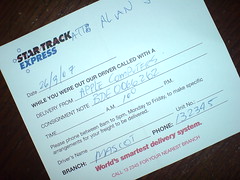
I may be Apple Australia's most expensive customer
Originally uploaded by thatjonesboy.
Since they insist on delivering products you buy from the Apple Store via courier only, and insist on that courier delivering it to you in person and getting your signature, and since the courier company can't be more specific about when they're going to arrive than "Wednesday" and is unable to ring you when they're on the way.
Courier company tells me that Apple pays them for another delivery charge every time they try to re-deliver it, and so far this is the fourth time they've tried to deliver my new AppleTV when I'm not home.
By my rough calculations, if this happened another 4-5 times, the cost of the delivery would be up around Apple's cost price on the AppleTV.
All that needs to change is for Apple Australia to offer additional delivery options; (1) no signature required; (2) no presence required; (3) pickup from nearest Australia Post branch. Offer these with the option of delivery insurance, and you've got yourself a convenient service.
Instead, what you've got is a time-wasting, costly and inconvenient service for me, for the courier company, and for Apple.
If your app were a person, what kind of person would it be?
Kathy Sierra is a technologist, a great writer, and looks good in a conference tee-shirt, no matter how baggy the schwag. She also has a great knack for analogies, like this blog post, where she asks, if your app was an employee, what kind of employee would it be?

It's clear to me from this description that Microsoft products are usually 'Anal-Retentive Guy', and getting more and more anal-retentive with each release, because Microsoft seems to think that's what we want when we ask for more security and stability in our operating system.
Like all good analogies, this is a simple exercise with really deep implications. BY all means ask yourself the 'which stereotype would it be?' question, but to get a more interesting answer, ask your employees and your customers. Each will be experiencing a different perspective of your product according to how they use it, support it, sell it and develop it.
Unfortunately all Kathy's stereotypes are negative, there's no match for products I love, like Comic Life. (Hmm... how about the guy you work with who always manages to take a menial, boring task and make it hilarious fun for you and the team?... we all know someone like that, right? ;-) OK, maybe positive stereotypes are a little hard!
Creating Passionate Users: Is your app an ass-kisser?
at
Wednesday, March 28, 2007
View Comments
![]()
Labels: strategy
3's X-Series: I'm underwhelmed...
I know that one day, the competitive forces of economics will make one network operator break from the pack and decide to offer an open, all-you-can-eat, internet and voice plan. They'll decide it's better to lose the margins on distinguishing between data and voice than to lose the customer. "OK!" They'll cry. "Choose whatever browser and apps you want on your phone, just like you do on your computer. Just download and upload your data through our pipes!"
When I read that 3 had launched its X-Series offering here in Australia, I thought maybe that day had arrived. But no, I must wait a little longer. Instead, 3's X-Series is more of the same mobile superhighway robbery, only this time they're claiming it's 'just like an ISP plan'. Don't be fooled; it's nothing of the sort. Fairfax quotes 3 boss Nigel Dews on this: "It is very similar to broadband pricing consumers know at home today, but in many cases will be much better value." Bollocks. The Australian X-Series offering would be "like an ISP plan" if your ISP restricted you to one of only four PC models, made its most generous plan $20 per Gb of data, limited the internet sites and software you could use, and then limited your use of that software, capping it to a certain number of minutes per month.
Fairfax quotes 3 boss Nigel Dews on this: "It is very similar to broadband pricing consumers know at home today, but in many cases will be much better value." Bollocks. The Australian X-Series offering would be "like an ISP plan" if your ISP restricted you to one of only four PC models, made its most generous plan $20 per Gb of data, limited the internet sites and software you could use, and then limited your use of that software, capping it to a certain number of minutes per month.
Initially excited to see Skype was one of the apps bundled with the handset, my enthusiasm faded when it became clear that only Skype-to-Skype calls are supported. No Skype-to-PSTN calls. Worse, even your use of Skype-to-Skype is capped, starting at 1,000 minutes per month on the cheapest plan and then 5c a minute thereafter.
Because X-Series plans are in addition to your voice minutes plan, you could quite easily find yourself paying a 5c a minute premium on your usual voice call rate to talk to Skype with someone on their PC using a device designed to place calls more easily and more quickly to their telephone! How attractive is that?
Your use of the other bundled apps and web services (Orb, a file-sharing app, Google search, Yahoo! Messenger, MSN Messenger and eBay) is also capped, with a 10c per Mb charge over your cap. Yes, that's cheaper than other Australian mobile networks. But are the kind of users savvy enough to want a mobile internet plan going to want a walled-garden of apps and web services? Do they need on-deck links to eBay and Google, or will they find that just a tad patronising? Most I know have these services bookmarked in Opera Mobile.
There is an uninspiring range of only four handsets available, omitting SonyEricsson, and surprisingly, not one of the phones supports all of the features and apps offered in X-Series plans. It's a question of 'which features can I live without?' when you come to choose your handset rather than 'which phone do I most like?'
Finally, the X-Series offering in Australia is considerably worse value than X-Series in other markets. Perhaps 3's reliance on Telstra to deliver some of the network is to blame, but X-Series is less expensive in Asia and the UK, and their plans are uncapped.
Tuesday, March 27
Never let the marketing dept use the CMS
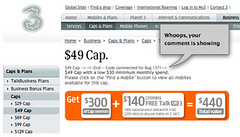
Never let the marketing dept use the CMS
Originally uploaded by thatjonesboy.
'Cos otherwise they're liable to learn just enough HTML to get themselves into trouble. Two free minutes of national talk time to the first person with "marketing" in their job title to correctly guess what's wrong with this example.
Thursday, March 22
Podcast showcase for .au iTunes Store and AppleTV

podcast showcase for .au itunes store and itv
Originally uploaded by thatjonesboy.
My xbox and MythTV-toting geekbuddies scoffed when I told them I'd advance-ordered an AppleTV months ago. "Oh dude, but there's, like, no content for it. If it's not already on your Mac, there'll be nothing for you to buy on iTunes Store when it finally ships!"
But I had faith in Jobs, and lo, he delivered. Well, the AppleTV itself was a little delayed, but I got a shipment notification yesterday saying it had left the warehouse, should be here before the weekend. And tonight when I was perusing the Australian iTunes Store, what should I come across in the Podcasts index page but this "AppleTV Showcase"?
Lo and behold, for within there are at least 16 video podcast channels I can subscribe to, and they're not all unknown content brands - I see Comedy Central and National Geographic in the mix there.
Beware Foxtel, your demise is almost at hand!
at
Thursday, March 22, 2007
View Comments
![]()
Labels: TV
The recording industry becomes the performing industry
Mike Arrington in Techcrunch has it absolutely right when he heralds the news that CD music sales were down a further 20% in 2006. It is good news, and yes, it is inevitable. I've followed Mike's lead and posted a YouTube video with this post, for the same reason. The video is a fan-recorded excerpt of ‘Live In London’ by James Cooper and band, on Youtube. By putting it on this website am I breaking copyright law, or marketing an artist on my label? The answer is both.
What’s that? Shocked to hear a record label owner looking forward to the decline of CD music sales? Well, the massive changes currently affecting the music industry are why my label exists. In any moment of dramatic change there is an opportunity for small, fast-moving businesses to gain a competitive advantage. The bigger the changes, and the faster they occur, the better, for the artists the label represents, and for you the music-buying public. Why? Let me spell it out:
You don’t consume music the way you used to. The industry is still configured to cater to the way we bought music 20 years ago: you saved up all your pocket money for a couple of weeks so that you could buy one, or at most, two new albums a month. Because your purchase volume was so low, the investment you made in the purchase decision was enormous. Your purchase decision research was 90% of the time you spent as a music consumer. Everything from lavish stadium shows to million-dollar music video to double-album-insert-art-pull-out-poster album production extravaganzas were all aimed at you in your purchase decision research phase, to influence you to buy one album over another.
If you still pay for the music you listen to (vs downloading it free via P2P or sharing burned CDs with friends) you don’t buy albums anymore because you can trial each track on an album and download only what you want, busting the album-sized products into EPs or single tracks. Smaller sized purchases and cheaper music online means that instead of 90% of your month spent researching and 10% spent purchasing, you spend 90% of your month making little nibble purchases, and almost none of your time researching.
Record labels can’t invest all that money trying to persuade you to buy one product anymore, because they can’t be sure when you’ll buy. You don’t make the same investment in researching your purchase, because if you don’t like what you’ve bought today, you can just buy something new tomorrow. So all the massive promotional and media infrastructure aimed at changing your album-buying decision is wasted.
The same internet technologies that changed the way you consume music have also changed the way music is produced and marketed. While its still possible to spend millions of dollars in a recording studio, that investment has no greater chance of breaking-even than a music which is created in a bedroom with a Mac and some midi software. Music’s marginal production costs are approaching zero.
Record labels used to be able to ‘gate’ the supply of new artists and music by forcing all aspiring artists through their production systems; systems that had evolved to extract the maximum profit for the label while minimising risk, leaving the artist saddled with the maximum risk and minimum share of profit. Now artists can exist entirely without a label, or do an end-run around the label production system - coming to meet the label only at the point at which their completed debut album has already sold a few thousand units, has been reviewed everywhere that matters, and has been played to a large and growing fan base online and offline worldwide.
A larger number of artists inevitably means much lower sales for each artist, as the music buying volume is shared more broadly. The old Top 10, Top 20, and Top 100 charts used to track the success of an artist will become meaningless because the market is changing from the Top 100 making 99% of the revenue to a market where 99% of the revenue is made by artists that don’t even appear on the chart.
The days of the music megastar are fading, and in a decade or so will be just a memory, replaced by ‘entertainment megastars’ of whom Paris Hilton is an early prototype. They will be wealthy from the proceeds of a variety of media, one of which will be music. These megastars will still be created by entertainment companies, but not record labels. Instead they will be owned by vertically-integrated media empires like News Corp.
For music artists, there will still a reasonable living to be made from music, but it will come from performance, not from the sale of recordings. For most of the history of popular music, this is how artists made a living, and its to this market we must now return. Because your recorded music will continue to decline in value until most of it is effectively free, it’s not something you can make a living from directly, but it remains the best tool for promoting your live performances and finding new audiences. The early signs are already here - while sales of CDs continue to dramatically drop, it looks like the revenues from live performance (these are US figures) were up 35% in 2006, and that mostly includes large shows - nobody yet tracks small venues.
You won’t be aiming to live in a mansion and drive a Ferrari anymore, but it will be possible to own your own home and put your kids through school, as long as you adapt to these changes as quickly as possible and develop the ability to engage and entertain a live audience through performance.
In Australia and elsewhere, there’s a lack of live performance venues, but this can be solved in a variety of ways; artist collectives investing in venues, labels investing in venues, and savvy investors investing in venues when they see how live performance will be the next big growth area in the entertainment industry. For the last 50 years we’ve believed that popular music must be performed after 9pm, on only a few nights of the week, only on premises licensed to serve alcohol, and they should preferrably be hard to find, smoky and dirty. That belief is as old as the Prohibition Era, so you should expect all that to change too.
Labels like Littoral which are small enough to adapt will start to focus on marketing the live performance of artists using recorded music and other means, such as managing the online presence of an artist, and the way we share profit with an artist will necessarily change too.
While nobody will be a megastar in the future of the music industry, many more artists will be able to make a good living from performing live, and more profit will be returned directly to the artist when the large record labels start to splinter and collapse - that’s the best news of all.
Labels: music
Tuesday, March 20
New Thumb Nano

new slim-line thumb profile
Originally uploaded by thatjonesboy.
With controls on electronic gadgets continuing to shrink, I thought it was time to start reducing the size of my own primary input devices, starting with my left thumb.
I created this Thumb Nano with a nice big chopping knife while preparing a dish of chicken tagine. Yes, the missing skin, nail bed and nail went into the tagine with everything else. No, nobody noticed. They were all too horrified at the blood I was losing.
Here's the result the next day at the medical centre, going in to get a new dressing applied.
Don't try this at home folks, it really eats into your typing speed!
Friday, March 16
Mix, pitch and bitch at STIRR Sydney 2

STIRR Sydney, my favourite Web 2.0 mix/pitch/bitch-session, is on again, Thursday 29th March, at 7pm. Find full details, gaze in horror at photos of STIRRs past, and RSVP for this one on the STIRR Sydney wiki.
STIRR can always use one more startup presentation and two more sponsors, so if you're looking for backing or looking to back, contact Marty at Tangler.
If you use Tangler (and who doesn't?) there's a Tangler group that will keep you up-to-date with STIRR Sydney as it comes together.
My grats to the Tangleros for putting this all together again, it's a lot of fun as long as somebody else does all the hard work behind the scenes.
Tuesday, March 13
It's not easy being me
Especially when my name is "Alan Jones". It's not enough that I cop all the comparisons to my 'evil twin' the radio broadcaster of the same name. It's not enough that my name elicits at least a chuckle when I get pulled over for speeding. And it's not enough that the other three Alan Joneses in the same postcode and I must re-deliver each other's mis-delivered mail.
For a while now, another gmail user have been receiving email addressed to each other. My gmail address has a period between the first and surnames, and his is periodless. It's no longer possible to register two usernames so alike, but for a time during gmail's exclusive invitation-only introduction, it was possible for the two of us, at least.
We both have separate accounts and logins (I can't see his Google Docs, for instance) but he's definitely a different user. I see all his emails from friends, confirmations of services he's signed up for, and even order confirmations that include address and demographic information. He's much less cautious than I am about what he uses his gmail account for. One of these days, some half-baked ecommerce site or a friend of his is going to email him his own credit card details, and I'd theoretically be able to go on a brief buying spree.
Google Help describes the way gmail ignores special chars in usernames as a feature, but in this case, it's definitely a bug.
We're not the only two people affected, in fact, Google's known about it since gmail came out of beta:
http://arstechnica.com/news.ars/post/20060120-6022.html
http://www.digg.com/software/Use_Gmail_Generate_Unlimited_E_mail_Addresses
Once the problem came to light, Google made a change that would prevent the problem occuring for future signups, but its only suggestion for those of us already suffering from the problem is to either register a new gmail address, or change your reply-to address and wait for your email buddies to update their contact details.
Neither I nor the other Alan Jones wants to give up our email address, and just changing the reply-to address isn't sufficiently secure as it only affects emails created when someone hits the 'reply to' button in their email client. Besides, I have another 600-odd business cards that advertise alan.jones@ as my email address that I'd like to use, thanks!
Perhaps there aren't enough litigous US gmail users who realise they have the problem to reach the critical mass necessary for a class action suit of some kind. It's not like Google to be pressured by anyone (except foreign governments) so I'm not even sure they'd care if a class action suit was raised.
Meanwhile, this problem ensures that I'll never use gmail the way Google always hoped I would: as my primary email account.
Friday, March 9
Payonce.com.au unfortunately... won't
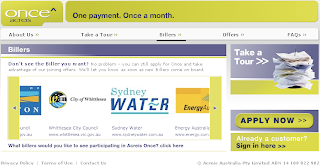
Our latest household water bill (less than a third of the Sydney average, w00t!) included a promo for www.payonce.com.au - a service for time-poor, tech-rich groovers with lots of big monthly bills like me. Do I like paying bills? No, not even if I can do it all online. I want to do it faster, cheaper... ideally, have someone else do it for me.
Payonce.com.au's promise is to get as close as possible, by aggregating all your bills and allowing you to pay them via one service. Even better, it allows you to pay all your bills in one payment each month, just pay the minimum due, or spread regular payments out across the month.
I was very excited; until I tried to sign up and it all went very pear-shaped. The promotion in my water bill told me Payonce was ready to solve my bill problems. Unfortunately, it has too many problems of its own to be able to solve any of mine.
Minor credibility gap
I'm the sort of trusting early-adopter who'll sign up for nearly any service online, even if it means disclosing all my banking, billing and credit card details. But I'm odd: the typical consumer needs more than a little reassurance about who they're about to deal with.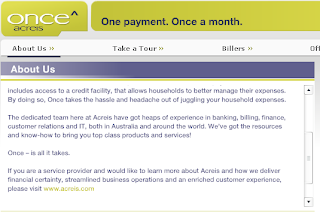
When I clicked on Payonce's 'About us' link I expected to get some concrete detail about the company's executive team, investors and strategic alliances. The best example I've seen of this is the extraordinary detailed company information Wesabe reveals, including names, resumes photos and blogs of the company's founders, all its investors and alliances. Why, they even set aside a couple of hours each day in which the CEO will answer your questions on a toll-free number (not sure whether that scales to millions of customers, but heck, what a great start).
To my great surprise, Payonce thinks you'll be satisfied with the following cottonball fluff:
The dedicated team here at Acreis have got heaps of experience in banking, billing, finance, customer relations and IT, both in Australia and around the world. We've got the resources and know-how to bring you top class products and services!I feel so much warmer and fuzzier than before. But who ARE the dedicated team? What exactly is the length and breadth of their various experiences? Are they safeguarding my banking details with their combined personal credit card limits, or with the financial guarantee of a bank or insurance company? I'm all in favour of friendly, informal 'voice' in a web startup's branding, but when you're dealing with my financial information, I'd like to see some hard facts too.
I wasn't reassured when I found there was no street address listed for the company, only a post office box in Tasmania (the outsourced telemarketing team capital of the southern hemisphere, like Mumbai, minus all the head wobbling.) There is also no ACN number advertised, only an ABN. I rang the 1300 number listed with the address and bounced around the phone tree until I was able to speak to a person, but she didn't reassure me much either:
Me: Can you give me your street address please?So that didn't reassure me very much.
Tasmanian working mum (TWM): You mean for head office?
Me: (thinks: no, your own home address! What do you reckon?) Yes, for 'head office'.
TWM: Umm... let me just bring that up for you now...
Me: (thinks: "bring it up?" You don't know where it is?)
TWM: Umm... sorry for the delay, it's just coming up now...
(four minutes later)
TWM: Umm... I'm really sorry, it's going very slowly today, let me try it for you again...
Me: No, it's OK, I'll call back later (much later!)
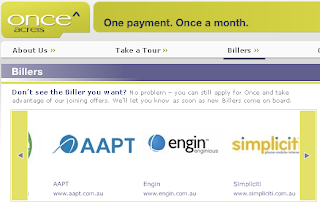 Major biller problems
Major biller problemsLet's start with the primary benefit: the ability to pay all of my bills. Full disclosure: my regular monthly bill pile includes bits of paper from Sydney Water, Energy Australia, Telstra, Internode, Australia Post, Citibank, Diners Club, Vodafone, Willoughby Council, RTA and those nasty, unpleasant people at the Office of State Revenue (only two more points on my driver's licence.)
How well does Payonce cover my regular billers? Well, this would be easy to establish if the site had a page just listing the billers, but in one of many user interface problems, it displays them in a horiz. scrolling display only wide enough to show 2.5 biller logos at a time. Thankfully, at the time of writing you don't need to scroll far, because there aren't yet many billers Payonce supports. Only two of my 11 regular billers are offered. That's only slightly more useful than useless.
Major competitors
Why so few billers? At a guess, I'd say Payonce is up against two factors:
- They won't admit it to your face, but most billers would prefer to reduce the number of different billing systems they offer. In Australia most consumers expect a biller to support cheque, over-the-counter, multiple credit and debit card providers, BPay and perhaps Australia Post's Billpay. Each payment method is a new payment gateway to integrate, new commercial relationship to be signed and serviced, and usage data to be collated and reported on. When Payonce can come to a biller with an installed base of hundreds of thousands of customers, it's got some leverage and may be able to dislodge another payment method. In the meantime, it can try to undercut its competitors, but margins are low and volumes high in the payment processing industry already.
- Some of the major billers Payonce would like to offer are direct competitors; primarily the local banks behind BPay and Australia Post, which offers Billpay.
Payonce's entire user interface is delivered in a window 745 x 385 pixels. Somebody there still thinks they need to design for an 800 x 600 display. So very 1997, and utterly charming until you try doing something like reading the FAQs, which must then scroll in a sub-window. Until you sign up, the masthead and right hand nav remain, reducing your usable interface to about 500 x 250. Approaching landscape-format mobile phone screen sizes!
Major browser compatability problems
I couldn't sign up. I tried Safari, Firefox and Flock on my Mac, and it consistently crashed all three browsers when I clicked on the 'Apply Now' button.
Which leads me to my conclusion: don't launch your service - and certainly don't spend your hard cash reserves on (relatively expensive) print marketing - until your service is much
closer to being ready for prime-time. Until your site is Mac browser friendly, use online targeting to display your ads only to PC users and browsers you support. Only target IP ranges known to be in locations where you know you have the local billers covered better than 75%. And if you can't offer to pay bills from NRMA, RACV, AMP and Telstra, just don't market at all. Buy your way into those billers no matter the cost. Until your brand delivers what it so clearly promises, you're churning as fast as you can pay to acquire customers.
Thursday, March 8
NEW! Pre-order the new Apple product before Steve pre-announces it

Now, I ain't no Photoshop pro, and I know I've used the wrong typeface, but hey. This was inspired by the popular item on Apple's 'iLaunch' in www.theonion.com.
Must... click... order... button...
Must... click... order... button...
Friday, March 2
At Google you can't get there from here
Is having a massive online audience, across a network of online products, enough to win? Not always. The best networks must involve the audience across products, and the products in the network must be monetisable. Google's a great example, both of what can go wrong and what can be done right.
Over coffee I asked a senior Google salesguy if it was hard selling ads on products that weren't made with ad sales in mind, across a network of products so loosely connected. He admitted that if AdWords' search inventory wasn't such a money-making machine, then making his targets on the rest of the network would be really tough. He then went on to tell me just how far over his targets the team were, and how they were too busy just counting the money to do much else (well, not quite in those words, but that was the gist of it.)
Still, it seems like Google (unlike the other networks) builds products mostly because they're cool, not because they might earn more revenue. I say that because so few of them display any advertising, and because the first premium Google product's only just been announced. While nobody worries about earning more revenue, it's not an environment that promotes network marketing - the kind of thinking that could introduce users of one product to other products on the network.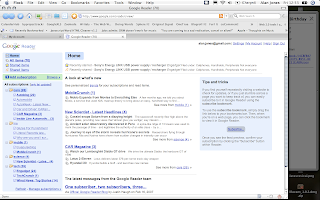
Example-du-jour? Google Reader. I'm so impressed with this product. Still in beta, yet it marches all over its competitors with hobnail boots, carrying a big stick and shouting a lot about ruling. I love the way I can just type in "mobilecrunch" and it will search and autodiscover the RSS feed, so I can add a new RSS feed in two clicks and a search term. I love the way it flags stories as 'read' as I scroll past them. I love being able to drag and drop feeds to reorder and drop them in a folder. I love lots more, but this post is not about how much I love Google Reader (though did I mention I love Google Reader?)
I first heard about Google Reader on another blog, which is always good for trial conversion because it comes with an endorsement from someone you trust. But another effective way to introduce a consumer to a product is via other related products the consumer uses - that's what networks are for. The very reason we call them "networks" is because we inherited the concept from television, where ad breaks have been used to promote other TV shows on the same network since the first Cold War. It's not a new concept.
Yet only recently have we seen the beginnings of 'network thinking' in Google's interface. Sometimes, some products from the rest of the network get a mention in the interface of another. Though when it does happen, it seems to have more to do with "here's another product developed by the same product group at Google" than "here's a product from elsewhere on the network that we think you'll like."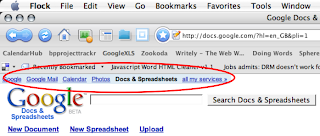
For instance, I'm writing this post in Google Docs, which has now become Google Docs & Spreadsheets (by the way, when it's time to call it "Google Docs, Spreadsheets, Presentations and Project Management" can we just call it "Google Office"? We're losing tongue-rollability.) Google Docs encourages you to use it as a blog editor, and as my blog's part of the Google network, it couldn't be simpler. And in the top left nav for Google Docs there's links to GMail, Calendar, Photos and search, presumably on the assumption that if you're comfortable creating and storing documents online, it's time you tried storing other work-type data there too (hmm... is Photos really a workplace product? Not sure why it's listed - part of the same product group?)
If, like me, you're using Google Docs to craft blog posts, it's a safe assumption you're also into reading blogs, so is there a link in the nav to Google Reader? Uhh no. Why not? Surely it's a natural fit. Microsoft Office doesn't have an RSS reader client in the suite but that's no reason why Google Office shouldn't include one.
Reverse that thinking, and you'd have to figure that Google Reader's navigation should include easy one-click access to Google Docs, right? Nope. In fact, Google Reader's got no network navigation, not even to search or Blogger. Despite having a 3-column nav with a scrolling pane view - so much easier to add a network navbar to.
If I return to the network navbar in Google D&S, there's another link that says "All my services...". Aha, that's what I've been missing, I think. I'll click on that link and a clever bit of asynchronous ajaxery will unfurl a longer navbar with the services I expect to have something in common with my current task...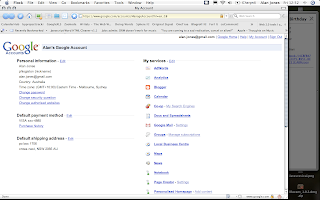
Oh no! I've landed on Google Accounts, which has more to do with managing my Google account IDs than accessing my Google services. Yes, there is a list of services I'm using there on the right, but it's a single-column vertical list that stretches wayyyy below the fold before it gets to Google Reader. Not only is the list not sorting itself according to the product most recently used, there's actually no way to reorder that list, change it to a horizontal list, or add or remove items from it without deleting your account. Google Accounts is not the way any Google user wants to navigate between services.
Yes, it's true, the Google homepage has made a virtue of the small, fast-loading page, and network navigation adds to that pageload. it's probably also likely that far more people type "Google Reader" into their search form (on Google, Yahoo! or whatever their default homepage is) to access the service than would click on a network link. But that assumes that the user knows about Google Reader, when network navigation should perform both the navigation task and the network marketing task.
It's possible that because Google Reader is still in beta, the product team are deliberately avoiding network navigation to control server load. But Reader seems like a mature app ready for the limelight, and that still doesn't explain the lack of network nav in Reader pointing to the other Google products.
If the beta status of the product doesn't explain the lack of network nav, does it perhaps explain the absence of AdWords integration? As far as I can tell, Google Reader seems like the perfect product for in-context text ads, much more so than GMail, where clickthru rates are limited by the strong task orientation of the product (when I'm have-way through writing an email, even an in-context ad for a product I want to buy won't get my attention.) An RSS feed is way more structured and contextual than the ramblings of my average email message; more than enough context there to ensure targeting is successful. Reading feeds is much less task-oriented than email, meaning clickthru rates should be higher, arguably higher than in search. Even the three column layout with scrolling viewer pane lends itself to keeping ads visible wherever the eye wanders.
My experience of Google makes me think that the real reason there's no ads is because the Google Reader team are Google developers. With a few exceptions, the Google developers I've met have the freedom to develop products without thinking about how to make them pay; are working with no revenue or network marketing goals to achieve; and are working within the pervasive and powerful Google culture. A culture that admits that while earning money may be necessary to keep the free pizza and espresso coming, the value of the developer's own compensation is largely determined by the sharemarket, which still values the company at an amazing multiple of earnings. If the value of my employee options far exceeds my salary, and there's only a tenuous relationship between revenue and the value of those options anyway, and my boss dislikes the very concept of advertising as much as I do, there's not much impetus to monetise the product I'm building.
Again: I love Google Reader to bits. I just wish I could get there from here.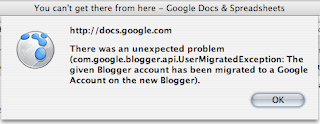
Postscript: this is too funny! I hit 'publish to my blog' and Google Docs tells me I can't do that because I migrated my blog from the 'old' Blogger to the 'new' Google Blogger. Which I did months ago, and which Google wanted me to do because it was part of bringing Blogger further into the Google Network. If there were anyone at Google with a network marketing mindset, don't you think they would have put the Blogger and Docs teams in a room and not let them out until this was fixed? Either that person doesn't exist or they're being treated like a mushroom.
at
Friday, March 02, 2007
View Comments
![]()
Labels: advertising, Google, network, strategy



